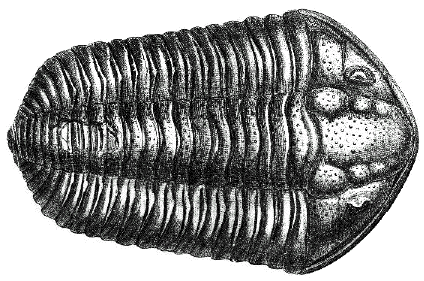 |
Trilobites are a well known, and easily recognizable,
extinct group of highly developed marine arthropods. They once flourished
in the ancient seas from the
beginning of the Cambrian period, some 570 million years ago, becoming
extinct at the end of the Permian period. Trilobites were the first
arthropods to appear, inhabiting the earth during the Paleozoic era.
|
| Trilobites are extinct arthropods. Arthropods
have segmented body appendages and are covered by a chitinous exoskeleton.
Examples of living arthropods include insects, crabs, centipedes, spiders
and lobsters. The name trilobite comes from the three longitudinal
lobes the body is divided into. They are the raised central lobe
or ridge, called the axis, with two lower lobes on either side. They
are also divided into a head called the cephalon, a central thorax of between
2 and 44 segments, and a tail shield called the glabella. The number
of segments is fixed within each species. The axial region of the
head shield, or glabella, has cheeks on either side. Many trilobites
have two well developed compound eyes, one on each cheek. Other trilobites
however, such as agnostids, were totally blind.
Each segment of the animals body carried a pair of jointed limbs
on the underside. These limbs are very rarely preserved in fossils, although
x-ray techniques have been used to reveal the legs, antennae, featherlike
gills and other appendages of some completely preserved trilobite fossils
from the Ordovician Utica Shale of New York state, and the Devonian Hunsrück
Slate of Germany.
How the fossils of trilobites are found has a large part to do with
trilobites having an articulate body encased in a hard external shell,
called an exoskeleton, which was divided up into segments. Because
of these segments, some species were able to roll up as their means of
defense. In fact, trilobites are sometimes found preserved in an
enrolled state. Most of the post-Cambrian trilobites could roll themselves
up into a ball when distressed. As with different living organisms
today, the trilobites shed or molted their exoskeleton periodically as
the animal increased in size. A new and larger outer shell was grown
in place of the original. The disarticulated remains of these molted
exoskeletons are often found individually, or sometimes they accumulated
in an area, possibly caused by the current actions of the water they inhabited.
Many have facial sutures across the head shield, where it would split so
the animal could crawl out of the exoskeleton, once it had outgrown it.
Many trilobite fossils are shed exoskeletons and lack part of the head
shield. A specimen containing the entire head shield, and the remainder
of the specimen along with it, represents the death of that trilobite. |
| Most trilobites were bottom dwellers,
walking on the sea floor. The tracks left behind by trilobites crawling
on the sea floor are preserved occasionally as trace fossils. Some
were burrowers living in the soft sediments of the sea floor, while others
were free swimming. Rusophycus is a horizontally oriented bilobate, ovoid
shaped burrow that has parallel to subparallel scratch marks laterally
extending from a central bisecting plane. An example of one can be
seen in the image above. It is believed to be a fossil impression
of where a trilobite, or another arthropod, once rested. Trilobites
appear to have been exclusively marine organisms, since their fossilized
remains are always found in rock containing fossils of other salt-water
animals, such as brachiopods, crinoids, and coral. To learn more
about these other marine organisms, just click on the appropriate icons
below. |
| There are about 10,000 known species of trilobites ranging
in size from 5mm to over 70cm (2 feet). Though they became extinct
over 240 million years ago, their fossil remains have been found on every
continent of the world. The reason for the extinction of the trilobites
is not clear, although it would seem to be no coincidence that their numbers
began to decrease with the arrival of the first sharks, and other early
fishes in the Silurian and Devonian periods. Perhaps the trilobites
were possibly a rich source of food for these new arrivals! Trilobite
fossils are found worldwide, and some of them serve as excellent zone or
index fossils, which enables geologists to date the age of the rocks in
which they are found. Some trilobites evolved into elaborate spiny
forms, particularly during the Devonian period. Such specimens are
found in the Devonian Hamar Laghdad formation of Alnif in Morocco.
To see images of trilobites of the more commonly recognized forms, or the
spiny forms, just click on the appropriate icon below |


